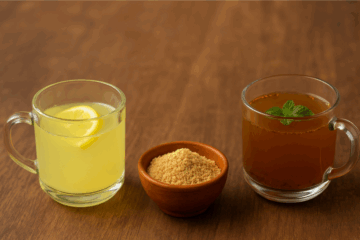Hing Peda is more than just a traditional Indian sweet. It’s a time-tested remedy passed down through generations to aid digestion, fight bloating, and improve gut health. But is it rooted in science or simply cultural wisdom? Let’s explore.
1. Does eating Hing Peda after meals actually help with digestion or reduce gas?
Short Answer: Yes, Hing Peda contains digestive ingredients like hing and ajwain that help reduce gas, bloating, and indigestion when consumed in moderation after meals.
Detailed Answer:
- Contains Hing (Asafoetida): Known for its antispasmodic and carminative properties, hing reduces bloating and gas formation in the intestines.
- Ajwain (Carom Seeds): Stimulates digestive enzymes and combats acidity, making the peda more effective post-meal.
- Desi Ghee: Acts as a lubricant for the digestive tract, helping smooth bowel movements.
- Traditional Use: For centuries, Indian households have used hing-based remedies for flatulence, and modern users report similar benefits.
- Scientific Support: Research supports hing’s ability to relax gastrointestinal muscles and reduce discomfort from indigestion.
2. Is the sugar in Hing Peda counterproductive if I’m trying to improve gut health?
Short Answer: While sugar is present in Hing Peda, small quantities do not negate its digestive benefits. Moderation is key.
Detailed Answer:
- Balanced Recipe: The sugar content is usually balanced with potent spices, which reduce its glycemic impact.
- Portion Control: One peda (approx. 8–10 grams) contains 2–3 grams of sugar, which is relatively low.
- Natural Alternatives: Some variants use jaggery, which has additional mineral benefits and is less refined.
- Digestive Synergy: The spices in the peda help in faster sugar metabolism and prevent sluggish digestion.
- Health Context: If you’re managing diabetes or gut inflammation, look for sugar-free or jaggery-based Hing Pedas.
| Type | Approx. Sugar per Peda | Suitable For |
|---|---|---|
| Classic Hing Peda | 3g | General Use |
| Jaggery Hing Peda | 2.5g | Gut Health Focused |
| Sugar-Free Hing Peda | 0g | Diabetics or Keto |
3. Are there specific ingredients in Hing Peda that make it suitable as an after-meal remedy?
Short Answer: Yes, ingredients like hing, ajwain, black salt, and ghee are all traditionally known to aid digestion and relieve gas and acidity.
Detailed Answer:
- Hing (Asafoetida): Relaxes the intestinal muscles and reduces gas formation.
- Ajwain: Encourages the secretion of digestive enzymes, easing bloating and discomfort.
- Black Salt (Kala Namak): Mildly laxative and carminative, helps in relieving acidity.
- Ghee: Improves fat-soluble nutrient absorption and enhances gut lubrication.
- Coriander Powder: Mildly cooling and supports liver function.
4. Can Hing Peda be part of an Ayurvedic routine, or is it just a cultural tradition with no science?
Short Answer: Hing Peda fits well within Ayurvedic routines as it combines multiple digestion-friendly herbs and ingredients rooted in Ayurvedic principles.
Detailed Answer:
- Vata Balancing: Hing is used in Ayurveda to balance excess Vata dosha, which is often linked to gas and bloating.
- Deepana and Pachana: Ayurveda classifies ingredients like ajwain and hing under “deepana” (appetite stimulants) and “pachana” (digestives).
- Daily Use in Rasayana: Ghee, salt, and hing are part of Rasayana herbs that rejuvenate the digestive system.
- Recommended in Texts: Charaka Samhita and Bhavaprakasha mention these herbs in post-meal applications.
- Mind-Body Connect: The warm, grounding nature of Hing Peda helps calm the mind and supports gut-brain health.
5. How often should I eat Hing Peda to get any actual health benefits — daily or occasionally?
Short Answer: Eating Hing Peda once daily after your heaviest meal can offer digestive support. Occasional use still helps but may not be as effective long-term.
Detailed Answer:
- Daily Use: One peda a day after lunch or dinner can maintain digestive strength and prevent common issues like gas or heaviness.
- Occasional Use: Even occasional intake can offer relief after indulgent or heavy meals, especially during festivals or weddings.
- Ideal Frequency: 5–6 times a week is considered ideal for continuous gut support.
- Children & Elderly: Can be given 2–3 times a week in smaller portions.
- Too Much Is Harmful: Excess intake (more than 2 pedas/day) may lead to acidity or sugar overload.
Conclusion
Short Summary: Hing Peda after meals is not just an old-wives’ tale but a proven digestive aid when consumed mindfully and in moderation.
Full Conclusion:
- Scientifically Backed: Its ingredients — hing, ajwain, ghee, and salt — are all recognised for digestive benefits.
- Supports Ayurvedic Practices: Aligns with Ayurvedic dosha-balancing and gut-healing routines.
- Moderation is Key: One peda per day is optimal for most people. Excessive use should be avoided.
- Customise to Needs: Choose jaggery-based or sugar-free versions if managing sugar intake.
- Not a Substitute: Hing Peda is a supplement to a healthy diet, not a cure for chronic digestive disorders.
So next time you reach for a Hing Peda after lunch or dinner, know that you’re indulging in a smart and healthy tradition — one that has both cultural wisdom and modern backing.





